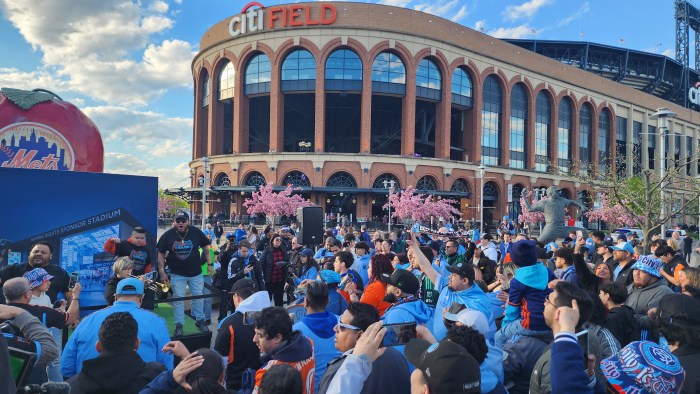By Dustin Brown
In the life span of landmarks, Flushing Town Hall stands out for waging a miraculous recovery from terminal neglect, while the RKO Keith’s Theater is hardly left standing at all — except maybe inches from death’s door.
The Flushing neighbors are like pop star sisters who basked in early fame before straying down the wrong path. After enjoying a golden age that was nothing short of luminous, they dallied on the wild side and succumbed to neglect.
But today, Flushing Town Hall has gracefully aged into a grand matron who shows hardly a wrinkle for all her hardship. She sits on Northern Boulevard with a healthy blush in her brick face and an expression of stately grace, old-fashioned yet somehow in the loop.
A step inside reveals why. The structure built in 1862 as a municipal building today houses a gallery of artwork that is progressive and edgy.
“First and foremost, we’re an anchor and a cultural landmark,” said Jo-Ann Jones, the executive director of the Flushing Council on Culture and the Arts, which has been based in the hall since its first renovation in the early 1990s. “Beyond that, we have tried to create a very welcoming and warm environment in which to create cultural forums and high-quality arts programming.”
By all accounts, the Town Hall has been born anew, playing a role in the community not unlike the purpose it was conceived for 140 years ago.
But the RKO Keith’s Theater, which sits two blocks to the west at Northern Boulevard and Main Street, is hardly as fortunate.
Its first floor is hidden behind a wall of wooden boards, denying access to an interior that is damaged and languishing from neglect and misuse. The window openings are windows no more, covered by rows of concrete blocks fused together by unevenly applied cement that hardened in sporadic globs.
Although there is little majesty left, touches of elegance still show, such as the steel frame of the marquee that rises and falls along a gentle curve mirrored in the stone wall behind it.
The lobby and its staircase, both of which are designated landmarks, are in disrepair. Tommy Huang, a developer who has owned the building since 1986, was convicted in 1999 on a felony count of ignoring asbestos contamination in the theater and spilling hundreds of gallons of fuel oil in its basement.
But the condition of the theater is not much different from where the Flushing Town Hall was a little more than a decade ago — and if Jones and the Flushing Council have their way, it eventually will follow a comparable path to recovery.
The Flushing Town Hall, designated a city landmark in 1967 and listed on the National Register of Historic Places in 1972, had degenerated by the 1980s into a source of neighborhood blight with a crumbling facade and broken windows, a property frequented by prostitutes and drug dealers.
Appalled by the decay of the historic site, a coalition of community groups collectively sued the city to gain authority over the building, which had been all but abandoned after a supper club failed in the mid-1970s.
The city ultimately won control on June 28, 1989 by court ruling, and the Flushing Council later was awarded the right to manage the building and undertake the seemingly overwhelming task of recapturing its original glory.
After decades of bouncing from one use to another, Flushing Town Hall was in dire need of repair.
“There was never a systematic attempt to maintain the building and do simple things like make sure the roof didn’t leak,” Jones said. “Everything came to a grinding halt when it was actually abandoned in the mid-80s.”
The hall was built in 1862 after inclement weather prevented the village of Flushing, which had no town auditorium, from holding a ceremony to send off a local regiment of the Union Army.
The project was riddled with scandal — such as when the architect earned a tidy profit by awarding a subcontract to none other than himself — and came in well over budget, but it opened in January 1864 with a grand inaugural ball.
As the town hall for Flushing, the building hosted touring theater companies and light operas, as well as municipal functions, and it served a wide variety of purposes at different times, ranging from courthouse to police station, library, and bank.
“Before, Barnum and Bailey Circus came, now there’s a jazz show with some famous jazz musicians,” said Howard Graf, the president of the Flushing Council. “I think that’s an incredible thing how the fit still[[don’t understand]] matches in a way what it was originally built for.”
Now the Flushing Council is looking to facilitate an appropriate use for the RKO Keith’s Theater, the once-glorious movie palace that opened in 1928 as part of the vaudeville circuit.
Graf, who is himself an architect, plans to scout for developers who may want to purchase the property from Huang — who is interested in selling — and find a viable use for it.
“It’s been an eyesore for 16 ears[[years???!]] now and it’s dragging down the entire downtown Flushing area, so we need to bring it back,” said City Councilman John Liu (D-Flushing), who said he saw his first film there as a child.
A recent visit inside the building revealed the space to be little less than stunning.
“It’s like stumbling on an archeological find. It’s like something you see in Rome,” Jones said. “It just takes your breath away.”
But even if a developer does come around to rescue RKO Keith’s, it is unlikely to face the same rosy future as Flushing Town Hall. The age of the 3,000-seat movie palace is over, and the idea of the site reemerging as a theater is unlikely — although Jones hopes to see community use incorporated into the final product.
“The sad part is, it’s not a theater anymore,” Jones said. “You feel like it’s an amphitheater, like a Roman relic.”
Reach reporter Dustin Brown by e-mail at Timesledger@aol.com or call 229-0300, Ext. 154.































